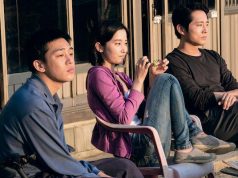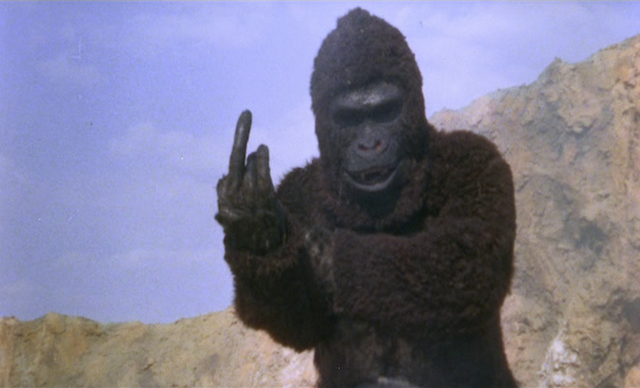
Today, South Korea is best known for two things: being the right answer when you’re trying to remember which of the two Koreas isn’t run by a lunatic, and producing bloody films about obsessed men seeking revenge against the people who killed their daughters. But our movie this week comes from a different time, a time when South Korea’s film industry was stagnant and depressed, a time when they were pleased to let any fly-by-night American production company roll into town, put a monkey suit on an actor, and film a “King Kong” ripoff. That time was the 1970s, of course — history’s most fruitful decade for pathetic things — and the movie was called “A*P*E.”

The asterisks are in the title to remind you of “M*A*S*H,” which was also set in Korea. Beyond that, “A*P*E” and “M*A*S*H” have nothing in common, except that they both have the same number of scenes in which a giant ape is portrayed in a convincing manner, i.e. zero. “A*P*E” was rushed into production when Dino de Laurentiis announced he was producing a remake of “King Kong.” As with many things that are hastily assembled, “A*P*E” is notable for its shoddy workmanship and reliance on inexpensive foreign labor.
We begin on a cargo ship in the Pacific Ocean. Two crew members discuss the 36-foot beast contained in the ship’s hold. Some movies would spend a lot of time showing us how the creature was captured, but “A*P*E” prefers to skip the excitement and get right to the part where it’s over and two guys are talking about it. One of them says he hopes the gas they used to render the animal unconscious does its job, and the other one says they have nothing to worry about, the beast should be asleep for another five days, whereupon the animal immediately bursts out of the hold and destroys the ship. It’s going to be that kind of movie.
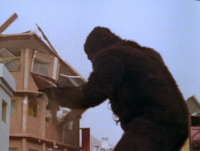
We’re dealing with a giant gorilla, of course, much like “King Kong” in principle. In practice, our gorilla is a shameful imitation of the mighty Kong, insofar as our gorilla is very clearly nothing more than a man who is wearing an ape costume. It’s not even a very good ape costume, and the man inside it doesn’t bother to act in an ape-like manner. It wouldn’t have been any less convincing if they’d skipped the costume altogether and just written “APE” on a piece of paper with a Sharpie and taped it to the guy’s shirt.
The gorilla isn’t given a name. Names are for winners. This 36-foot loser is called “the gorilla” and “the monkey” by the people in the movie. We’re going to call him Ape, because we assume he is the title character. Ape wades through the ocean (which I guess is less than 36 feet deep in these parts), fights a shark that’s the same size he is (just for the fun of it), then walks ashore in South Korea and wrecks a village. All of this occurs matter-of-factly, without any fanfare or enthusiasm. “Yep, it’s a giant ape,” the movie seems to say. “He’s gonna smash some stuff. Yep, there he goes…. Might as well settle in, folks, he’s gonna be at it for a while.” Look, the producer’s nephew’s woodshop class went to the trouble of building some flimsy models that kind of look like houses, so whoever’s in that ape costume is damn well going to smash them all.
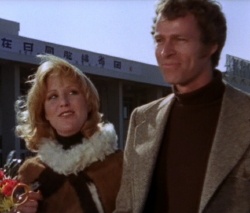
The next day, an American actress arrives in Seoul to shoot a film. Her name is Marilyn, and she’s the mom from “Growing Pains”! What a welcome surprise! We are so glad to see her that we do not stop to wonder why news of a seaside village being destroyed by a 36-foot gorilla the night before has failed to spread, even though you’d think that would be a pretty big deal. Anyway, Marilyn is greeted at the airport by a guy named Tom (Rod Arrants), a very smug, very 1970s, very turtleneck-wearing journalist who is also Marilyn’s occasional part-time boyfriend back in Los Angeles. She didn’t know he was going to be here! Turns out he got an assignment in Seoul so that he could be near Marilyn while she shoots her film, a surprise that Marilyn finds delightful rather than obsessive or controlling. Tom also hopes to have a lot of sex with Marilyn while she’s in town. To this idea she is alarmingly receptive.
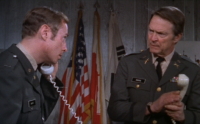
Now we come to a crucial part of any monster movie: the scenes of ineffectual military leaders dithering in echoey paneled offices. Usually they refuse to believe the monster exists for a few scenes before shifting into the phase where they botch numerous attempts to destroy it. The beige men filling these roles in “A*P*E” are Col. Davis (Alex Nicol) and Lt. Smith (Jerry Harke), officers at the U.S. military base who specialize in arguing, smoking cigarettes, and yelling “What?!” and “Are you sure?!” into telephones. Most movies of this genre have scenes like this; you can tell how bad the movie is by how many of them it has. “A*P*E” is probably 49 percent guy in gorilla costume knocking over scenery pieces, and 49 percent oatmeal-colored Army men filibustering.
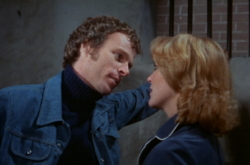
The other 2 percent is “Growing Pains” Mom and smug journalist boyfriend. We soon see Marilyn on the set of her movie, a seedy-looking enterprise that probably wasn’t intended to look this seedy. She and her co-star are rehearsing her rape scene. There’s a sweaty director, a camera guy, and a dude holding a boom mic — that’s it, no other crew whatsoever. That doesn’t say “Hollywood production shooting on location in Seoul.” That says “pornography being filmed in San Fernando.” Then again, this might be what the people who made “A*P*E” think a tasteful, professional production looks like, the same way people who read TMZ think People magazine is fancy.
In any event, an exceedingly horny Ape happens upon the set and abducts Marilyn, as expected. (She runs directly into his open palm.) Lacking an Empire State Building, Ape takes Marilyn out into a nondescript field and stashes the screaming “Growing Pains” mom in a cave while he fights with the military, which has finally swung into action. The soldiers fire bullet after useless bullet at Ape; Ape responds by smashing the tanks and killing a lot of soldiers. Marilyn, instead of using this distraction as an opportunity to flee, stays in the cave and screams. She does this until Tom the smarmy reporter “rescues” her, which he does by getting within earshot of her and calling her name, causing her to run toward him and thus to safety, as if she were a beagle.
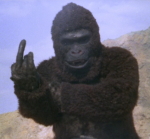
Marilyn stays out of harm’s way for a while, during which time Col. Davis and Lt. Smith engage in additional bickering and telephone-yelling-into. Ape fights with the Army some more, too, but his heart’s not in it. He misses his girlfriend, “Growing Pains” mom. “Show me that smile again!” he seems to think. He smashes a helicopter into the wall of a canyon, then looks at the camera and — I swear this is true — flips us off. The giant ape gives us the finger. How such a deconstruction of the Ape character, not to mention the breaking of the fourth wall, fit into the filmmakers’ artistic vision I cannot imagine, but I applaud them for having the courage to pursue it in the face of what must have been strenuous objection from everyone they mentioned the idea to. (“We’re going to have the monkey flip off the camera!” “What? No. Come on.”) Sometimes you just have to go with your first instinct, no matter how stupid it is.
Speaking of instincts and stupid things, Ape lumbers into downtown Seoul and begins systematically tearing apart buildings looking for Marilyn, in a sequence as tedious and lifeless as the previous several destruction sequences. At long last he finds her and abducts her again, leading to more firefights with the military, leading us to fear that somehow the movie is stuck on a loop. But no, eventually Ape gets what all living creatures deserve, i.e., death. Rather spectacularly, too: a rocket to the chest finally does the trick (after a thousand others didn’t), and Ape spits out blood! More fantasy creatures in movies need to spit out blood when they’re dying. I mean it. Picture a unicorn doing that. It’s great, right?
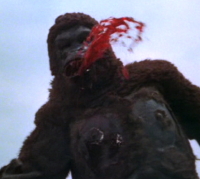
Col. Davis has this to say upon the ape’s death: “Let’s see him dance for his organ grinder now!” As if all monkeys are employed by organ grinders. That’s such an offensive stereotype. But speaking of grinding organs, Tom is happy to have Marilyn in his arms again, as he hopes she can forget all the unpleasantness of the day and get back to the task of having sex with him. I’m not convinced she’s better off with this self-important tool than she was with Ape. The gorilla was intimidating, but at least he didn’t wear turtlenecks all the time.
https://www.youtube.com/watch?v=943pcaqVQos
— Film.com


